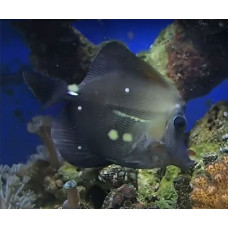Latin name
Zebrasoma scopas
Other name
Twotone tang, scopas tang, brush-tail tang.
Identification
These fish have a thick body compressed at the sides and a protruding face.
Features of fish fins
These fish have a relatively large dorsal fin. It is sail-like, with 4 or 5 spines and 23 to 25 soft rays. The anal fin has 3 spines and 19 to 21 soft rays.
Fish colouring
The head is whitish and the body is pale brown, changing to dark brownish black at the black tail. The head has faint longitudinal lines of pale green color that begin as dots and become continuous and then dotted again on the back. Juveniles are slightly paler and have yellowish stripes on the front. They also have relatively large dorsal fins. Adults have a white spine on the tail.
Distribution
They live in the Indo-Pacific region. Their range extends from the coast of East Africa to Japan, the Pitcairn Islands, Malaysia, Indonesia, Japan, Australia, Lord Howe Island and Rapa Iti. They have been sighted near Fort Lauderdale, Florida, well outside their natural range.
Habitat
A marine tropical species. They usually live on the open side of reefs and in coral-rich lagoons at depths of up to 200 feet (60 meters).
Size
The maximum published standard length is 16 inches (40 centimeters).
Behavior
Adults are social and sometimes form schools, juveniles are solitary and are often found swimming among the corals. Form permanent spawning aggregations.
Food and feeding habits
They feed mainly on filamentous algae. They have special pharyngeal teeth for this purpose.
Reproduction
The brown tang is monogamous, although spawning has been observed in pairs and small groups. Males are usually larger than females. Fish surface to spawn, fertilization occurs externally, and eggs disperse into the water column. The larvae remain in a planktonic state for several weeks before settling and developing into juveniles.
Fishing
Have no commercial value. Of no interest to fishermen.
Relationship with a person
They are one of the most peaceful species and can be kept with other species.
The meat of this fish is never poisonous.
| Classification | |
| Phylum | Chordata |
| Class | Actinopterygii |
| Squad | Acanthuriformes |
| Family | Acanthuridae |
| Genus | Zebrasoma |
| Species | Z. scopas |
| Features | |
| Conservation status | Least Concern |
| Habitat | Pelagic |
| Life span, years | No information |
| Maximum body weight, kg | No information |
| Maximum length, cm | 40 |
| Sailing speed, m/s | No information |
| Threat to people | Edible |
| Way of eating | Bentophage |
Brown tang
Tags: brown tang



